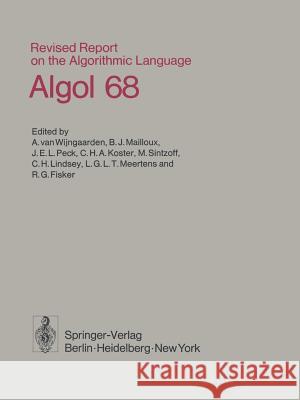Revised Report on the Algorithmic Language Algol 68 » książka



Revised Report on the Algorithmic Language Algol 68
ISBN-13: 9783540075929 / Angielski / Miękka / 1976 / 238 str.
Revised Report on the Algorithmic Language Algol 68
ISBN-13: 9783540075929 / Angielski / Miękka / 1976 / 238 str.
(netto: 428,36 VAT: 5%)
Najniższa cena z 30 dni: 450,85 zł
ok. 16-18 dni roboczych.
Darmowa dostawa!
Springer Book Archives
0. Introduction.- 0. Introduction.- 0.1. Aims and principles of design.- 0.1.1. Completeness and clarity of description.- 0.1.2. Orthogonal design.- 0.1.3. Security.- 0.1.4. Efficiency.- 0.2. Comparison with ALGOL 60.- 0.3. Comparison with the language defined in 1968.- 0.4. Changes in the method of description.- I Preliminary definitions.- 1. Language and metalanguage.- 1.1. The method of description.- 1.1.1. Introduction.- 1.1.2. Pragmatics.- 1.1.3. The syntax of the strict language.- 1.1.3.1. Protonotions.- 1.1.3.2. Production rules and production trees.- 1.1.3.3. Metaproduction rules and simple substitution.- 1.1.3.4. Hyper-rules and consistent substitution.- 1.1.4. The semantics.- 1.1.4.1. Hypernotions, designation and envelopment.- 1.1.4.2. Paranotions.- 1.1.4.3. Undefined.- 1.1.5. Translations and variants.- 1.2. General metaproduction rules.- 1.3. General hyper-rules.- 2. The computer and the program.- 2.1. Terminology.- 2.1.1. Objects.- 2.1.1.1. Values, locales, environs and scenes.- 2.1.1.2. Modes.- 2.1.1.3. Scopes.- 2.1.2. Relationships.- 2.1.3. Values.- 2.1.3.1. Plain values.- 2.1.3.2. Names.- 2.1.3.3. Structured values.- 2.1.3.4. Multiple values.- 2.1.3.5. Routines.- 2.1.3.6. Acceptability of values.- 2.1.4. Actions.- 2.1.4.1. Elaboration.- 2.1.4.2. Serial and collateral actions.- 2.1.4.3. Initiation, completion and termination.- 2.1.5. Abbreviations.- 2.2. The program.- II Fundamental constructions.- 3. Clauses.- 3.1. Closed clauses.- 3.2. Serial clauses.- 3.3. Collateral and parallel clauses.- 3.4. Choice clauses.- 3.5. Loop clauses.- 4. Declarations, declarers and indicators.- 4.1. Declarations.- 4.2. Mode declarations.- 4.3. Priority declarations.- 4.4. Identifier declarations.- 4.5. Operation declarations.- 4.6. Declarers.- 4.7. Relationships between modes.- 4.8. Indicators and field selectors.- 5. Units.- 5.1. Syntax.- 5.2. Units associated with names.- 5.2.1. Assignations.- 5.2.2. Identity relations.- 5.2.3. Generators.- 5.2.4. Nihils.- 5.3. Units associated with stowed values.- 5.3.1. Selections.- 5.3.2. Slices.- 5.4. Units associated with routines.- 5.4.1. Routine texts.- 5.4.2. Formulas.- 5.4.3. Calls.- 5.4.4. Jumps.- 5.5. Units associated with values of any mode.- 5.5.1. Casts.- 5.5.2. Skips.- III Context dependence.- 6. Coercion.- 6.1. Coercees.- 6.2. Dereferencing.- 6.3. Deproceduring.- 6.4. Uniting.- 6.5. Wideningm.- 6.6. Rowing.- 6.7. Voiding.- 7. Modes and nests.- 7.1. Independence of properties.- 7.2. Identification in nests.- 7.3. Equivalence of modes.- 7.4. Well-formedness.- IV Elaboration-independent constructions.- 8. Denotations.- 8.1. Plain denotations.- 8.1.1. Integral denotations.- 8.1.2. Real denotations.- 8.1.3. Boolean denotations.- 8.1.4. Character denotations.- 8.1.5. Void denotation.- 8.2. Bits denotations.- 8.3. String denotations.- 9. Tokens and symbols.- 9.1. Tokens.- 9.2. Comments and pragmats.- 9.3 Representations.- 9.4. The reference language.- 9.4.1. Representations of symbols.- 9.4.2. Other TAX symbols.- V Environment and examples.- 10. Standard environment.- 10.1. Program texts.- 10.1.2. The environment condition.- 10.1.3. The method of description of the standard environment.- 10.2. The standard prelude.- 10.2.1. Environment enquiries.- 10.2.2. Standard modes.- 10.2.3. Standard operators and functions.- 10.2.3.0. Standard priorities.- 10.2.3.1. Rows and associated operations.- 10.2.3.2. Operations on boolean operands.- 10.2.3.3. Operations on integral operands.- 10.2.3.4. Operations on real operands.- 10.2.3.5. Operations on arithmetic operands.- 10.2.3.6. Operations on character operands.- 10.2.3.7. Operations on complex operands.- 10.2.3.8. Bits and associated operations.- 10.2.3.9. Bytes and associated operations.- 10.2.3.10. Strings and associated operations.- 10.2.3.11. Operations combined with assignations.- 10.2.3.12. Standard mathematical constants and functions.- 10.2.4. Synchronization operations.- 10.3. Transput declarations.- 10.3.1. Books, channels and files.- 10.3.1.1. Books and backfiles.- 10.3.1.2. Channels.- 10.3.1.3. Files.- 10.3.1.4. Opening and closing files.- 10.3.1.5. Position enquiries.- 10.3.1.6. Layout routines.- 10.3.2. Transput values.- 10.3.2.1. Conversion routines.- 10.3.2.2. Transput modes.- 10.3.2.3. Straightening.- 10.3.3. Formatless transput.- 10.3.4. Format texts.- 10.3.5. Formatted transput.- 10.3.6. Binary transput.- 10.4. The system prelude and task list.- 10.4.1. The system prelude.- 10.4.2. The system task list.- 10.5. The particular preludes and postludes.- 10.5.1. The particular preludes.- 10.5.2. The particular postludes.- 11. Examples.- 11.1. Complex square root.- 11.2. Innerproduct 1.- 11.3. Innerproduct 2.- 11.4. Largest element.- 11.5. Euler summation.- 11.6. The norm of a vector.- 11.7. Determinant of a matrix.- 11.8. Greatest common divisor.- 11.9. Continued fraction.- 11.10. Formula manipulation.- 11.11. Information retrieval.- 11.12. Cooperating sequential processes.- 11.13. Towers of Hanoi.- 12. Glossaries.- 12.1. Technical terms.- 12.2. Paranotions.- 12.3. Predicates.- 12.4. Index to the standard prelude.- 12.5. Alphabetic listing of metaproduction rules.
1997-2025 DolnySlask.com Agencja Internetowa
KrainaKsiazek.PL - Księgarnia Internetowa









